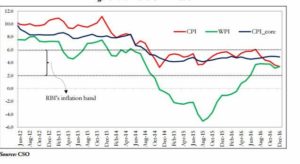Indian Budget 2017-18
At a Glance
The budget for 2017-18 was presented on 1st February, 2017 as against the normal date of 28th February every year.
This year budget is exemplary primarily because the financial year 2017-18 is an exceptional fiscal period due to the following schemes announced by the Government:-
- Income declaration scheme, 2016
- Demonetisation
- Pradhan Mantri Garib Kalyan Yojana, 2016
The aforesaid schemes have had a very serious impact on the economy of the country. Schemes like demonetization have taken not only India but the entire world by surprise. The impact is so far reaching that perhaps the economic life of the entire population of India will undergo a very significant change.
Therefore, the budget for this period assumes unprecedented importance.
ECONOMIC INDICATORS
Gross Domestic Product
Actual GDP growth in the first half of the year was 7.2 percent, however the projection for the same was only 7.0-7.75 per cent in the Economic Survey of 2015-16 and somewhat lower than the 7.6 percent rate recorded in the second half of 2015-16. The main problem was fixed investment, which declined sharply as stressed balance sheets in the corporate sector continued to take a toll on firms spending plans.
The Sector wise Growth in GDP is given in the below table:
| Sector | Growth in 2016-17 | Growth in 2015-16 |
| Agriculture | 4.1 | 1.2 |
| Industry | 5.2 | 7.4 |
| Services | 8.8 | 8.9 |
| Total | 7.1 | 7.6 |
 Inflation
Inflation
Inflation remained under control for the third successive financial year. Inflation this year has been characterized by two distinctive features. The Consumer Price Index (CPI)-New Series inflation, which averaged 4.9 per cent during April-December 2016, has displayed a downward trend since July. The decline in pulses prices has contributed substantially to the decline in CPI inflation which reached 3.4 percent at end-December.
External Sector
Export
The value of India merchandise exports (customs basis) declined by 15.5 per cent to US $262.3 billion in 2015-16 mainly due to slowdown in the value of global trade owing to the decline in global commodity prices and weak demand. In 2016-17 (April-December), exports increased marginally by 0.7 per cent (US$ 198.8 billion vis-vis US$ 197.3 billion in the corresponding period of the previous year).
Import
Imports had declined by 15.0 per cent in 2015-16. Imports at US$ 275.4 billion in 2016-17 (April-December) showed a decline of 7.4 per cent from the US$ 297.4 billion in the corresponding period of the previous year. Imports of petroleum, oil and lubricants (POL) declined by 10.8 per cent in 2016-17 (April-December) to US$ 60.9 billion from US$ 68.3 billion in the corresponding period of the previous year.
Trade Deficit
Trade deficit decreased to US$ 76.5 billion during 2016- 17 (April- December), from US$ 100.1 billion in the corresponding period of the previous year. Based on the Balance of Payments (BoP) data available for the first six months of 2016-17, the trade deficit on BoP basis declined to US$ 49.5 billion in April-September 2016 from US$ 71.3 billion in April-September 2015.
FDI
During 2016-17 (April-September), net FDI inflows of US$ 21.3 billion showed an increase of 28.8 per cent over April-September 2015, while net portfolio inflows were positive at US$ 8.2 billion in 2016- 17 (April-September) as against net outflows of US$ 3.5 billion in the corresponding period of the previous year.
Current Account Deficit
Current account deficit (CAD) was at US$ 3.7 billion (0.3 per cent of GDP) in April-September 2016 as compared to US$ 14.7 billion (1.5 per cent of GDP) in April-September 2015.
Foreign Exchange Reserve
On BoP basis, there was net accretion to India foreign exchange reserves by US$ 15.5 billion in 2016-17 (April-September), while it increased by US$ 11.8 billion including valuation changes. This resulted in increase in the stock of foreign exchange reserves, which stood at US$ 372.0 billion at end September, 2016.
Fiscal Deficit
In 2016-17, fiscal deficit and revenue deficit were budgeted at 5, 33,904 crore (3.5 per cent of GDP) and 3, 54,015crore (2.3 per cent of GDP) respectively.
SECTOR WISE DEVELOPMENT
Industrial Sector
As per the first advance estimates of the CSO, growth rate of the industrial sector comprising mining & quarrying, manufacturing, electricity and construction is projected to decline from 7.4 per cent in 2015-16 to 5.2 per cent in 2016-17. During April-November 2016-17, a modest growth of 0.4 per cent has been observed in the Index of Industrial Production (IIP) which is a volume index with base year of 2004-05. This was the composite effect of a strong growth in electricity generation and moderation in mining and manufacturing.
Infrastructure Sector
The eight core infrastructure supportive industries, viz. coal, crude oil, natural gas, refinery products, fertilizers, steel, cement and electricity that have a total weight of nearly 38 per cent in the IIP registered a cumulative growth of 4.9 per cent during April-November, 2016-17 as compared to 2.5 per cent during April-November, 2015- 16. The production of refinery products, fertilizers, steel, electricity and cement increased substantially, while the production of crude oil and natural gas fell during April-November, 2016-17. Coal production attained lower growth during the same period. Thermal power with a growth of 6.9 per cent boosted overall power generation while hydro and nuclear power generation contracted marginally during April-September 2016.
Corporate Sector
The performance of corporate sector (Reserve Bank of India, January 2017) highlighted that the growth in sales was 1.9 per cent in Q2 of 2016-17 as compared to near stagnant growth of 0.1 per cent in Q1 of 2016-17. The growth of operating profits decelerated to 5.5 per cent in Q2 of 2016-17 from 9.6 per cent in the previous quarter. The Y-o-Y growth in interest expenses remained flat in Q2 of 2016-17, as compared to 5.8 per cent in the previous quarter. Growth in net profits registered a remarkable growth of 16.0 per cent in Q2 of 2016-17, as compared to 11.2 per cent in Q1 of 2016-17.
Service Sector
As per RBI BoP data, India services exports declined by 2.4 per cent in 2015-16 as a result of slowdown in global output and trade. However, in H1 of 2016-17, services exports increased by 4.0 per cent compared to 0.3 per cent growth in the same period of previous year. Growth of net services, which has been a major source of financing India trade deficit in recent years, was (-) 9.0 per cent in 2015-16 and (-) 10.0 per cent in H1 of 2016-17 due to relatively higher growth in imports of services. Growth of software exports which accounted for 48.1 per cent share in services exports was 1.4 per cent in 2015-16 and 0.1 per cent in H1 of 2016-17.
Banking Sector
The performance of the banking sector, public sector banks (PSBs) in particular, continued to remain subdued in the current financial year. The asset quality of banks deteriorated further. The gross non-performing assets (GNPA) ratio of scheduled commercial banks (SCBs) increased to 9.1 per cent from 7.8 per cent between March and September 2016.
Non- food credit (NFC) outstanding grew at sub- 10 per cent for all the months except for September 2016. Credit growth in industrial sector remained persistently below 1 per cent level in all the months during the current fiscal.
SCHEME INTRODUCED FOR UNEARTHING BLACK MONEY
INCOME DECLARATION SCHEME, 2016
The Government, with intent to remove black money from the economy, gave an opportunity to persons who have not paid full taxes in the past to come forward and declare the undisclosed income and pay tax, surcharge and penalty totaling in all to forty-five per cent of such undisclosed income. The scheme was effective for the period starting from 1st June 2016 to 30th September 2016.
Impact
These steps resulted in a tremendous response from the general public, especially in the last two months. Income in the form of cash and undeclared assets amounting to Rs. 65,250 Crore was declared in 64,275 declarations filed upto the midnight of 30th September, 2016.
DEMONETISATION
The Government in its another major step towards curbing black money from the economy announced a historic measure, with profound implications for the economy. The two largest denominations notes, 500 and 1000, were demonetized with immediate effect from 08th November, 2016 and ceased to be legal tender except for a few specified purposes. These notes
were to be deposited in the banks by December 30, 2016.
PRADHAN MANTRI GARIB KALYAN YOJANA, 2016
The Scheme provides an opportunity to persons having undisclosed income in the form of cash or deposit in an account maintained with a specified entity (which includes banks, post office etc.) to declare such income and pay tax, surcharge and penalty totaling in all to 49.9 per cent.of such declared income. Besides, the Scheme provides that a mandatory deposit of not less than 25% of such income shall be made in the Pradhan Mantri Garib Kalyan Deposit Scheme, 2016 which has separately been notified by the Department of Economic Affairs. The deposit shall bear no interest and the amount deposited shall have a lock-in period of four years.
Period
The scheme is effective for the period starting from 17th December 2016 to 31.03.2017
Impact
As on date, no data has been released in respect of income declared under the aforesaid scheme. However, it is expected that the scheme would help the Government in achieving its object of unearthing the black money.
DIRECT TAXES
| Categories | Individual(Age less than 60 | Resident Individual | Resident Individual | |||||||||
| years)/ HUF/AOP/BOI/Artificial | ||||||||||||
| juridical person | (80 years ‰¤Age ‰¥ 60 years) | (Age ‰¥ 80 years) | ||||||||||
| Existing | UptoRs. 2,50,000 | Nil | UptoRs. 3,00,000 | Nil | Up to Rs. 5,00,000 | Nil | ||||||
| Rs. 2,50,001 -Rs 5,00,000 | 10% | Rs. 3,00,001 – Rs.5,00,000 | 10% | Rs.5,00,000- | 20% | |||||||
| Rs.10,00,000 | ||||||||||||
| Rs.5,00,001 – Rs.10,00,000 | 20% | Rs.5,00,001- Rs.10,00,000 | 20% | |||||||||
| Above Rs. 10,00,000 | ||||||||||||
| Above Rs. 10,00,000 | 30% | Above Rs. 10,00,000 | 30% | 30% | ||||||||
| Post | UptoRs. 2,50,000 | Nil | UptoRs. 3,00,000 | Nil | No Change | |||||||
| Budget | Rs. 2,50,001 -Rs. 5,00,000 | 5% | Rs. 3,00,001- Rs.5,00,000 | 5% | ||||||||
| amend | ||||||||||||
| ment | Rs.5,00,001 – Rs.10,00,000 | 20% | Rs.5,00,001- Rs.10,00,000 | 20% | ||||||||
| Above Rs. 10,00,000 | 30% | Above Rs. 10,00,000 | 30% | |||||||||
| Applicable | AY 2018-19 | |||||||||||
| Date/ Year | ||||||||||||




